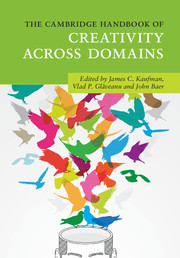Book contents
- The Cambridge Handbook of Creativity Across Domains
- The Cambridge Handbook of Creativity Across Domains
- Copyright page
- Dedication
- Contents
- Figures
- Tables
- Contributors
- Acknowledgments
- Part I Creativity and Domain
- Part II Creativity in the Traditional Arts
- Part III Creativity in the Sciences
- 12 Creativity in the Physical Sciences
- 13 Biomedicine, Creativity, and the Story of AIDS
- 14 Creativity in Psychology
- 15 Creativity in the Engineering Domain
- 16 Creativity in the Domain of Mathematics
- 17 Creativity Within Computer Science
- Part IV Creativity in Business
- Part V Newer Domains for Creativity Research
- Part VI Creativity in Everyday Life
- Part VII Conclusion
- Index
- References
15 - Creativity in the Engineering Domain
from Part III - Creativity in the Sciences
Published online by Cambridge University Press: 15 September 2017
- The Cambridge Handbook of Creativity Across Domains
- The Cambridge Handbook of Creativity Across Domains
- Copyright page
- Dedication
- Contents
- Figures
- Tables
- Contributors
- Acknowledgments
- Part I Creativity and Domain
- Part II Creativity in the Traditional Arts
- Part III Creativity in the Sciences
- 12 Creativity in the Physical Sciences
- 13 Biomedicine, Creativity, and the Story of AIDS
- 14 Creativity in Psychology
- 15 Creativity in the Engineering Domain
- 16 Creativity in the Domain of Mathematics
- 17 Creativity Within Computer Science
- Part IV Creativity in Business
- Part V Newer Domains for Creativity Research
- Part VI Creativity in Everyday Life
- Part VII Conclusion
- Index
- References
Summary
Engineering can claim an important association with the birth of the modern creativity era. The Sputnik Shock of 1957 led to the identification of creativity not only as a valuable quality in general, but also as a vital element of practical, successful problem solving. The engineering domain epitomizes the interdependence of the Four Ps of creativity – Person, Product, Process, and Press – highlighting the necessity of each as a component of generating effective and novel solutions to problems.
In this chapter, we discuss both what makes engineering unique as a domain of creativity, and also how important the core, psychological constructs of creativity are to this domain. We discuss, in particular, two facets of creativity – the characteristics of creative products, and the measurement of divergent thinking – where insights from the domain of engineering add value to the understanding of creativity as a systems phenomenon.
- Type
- Chapter
- Information
- The Cambridge Handbook of Creativity across Domains , pp. 261 - 275Publisher: Cambridge University PressPrint publication year: 2017
References
- 8
- Cited by



